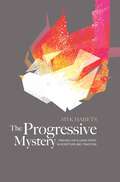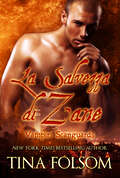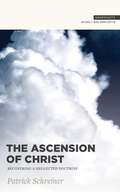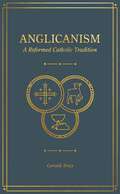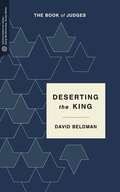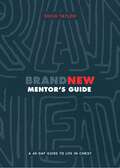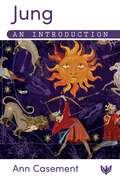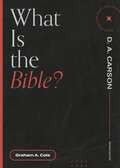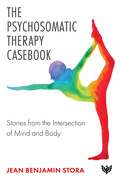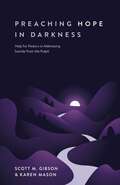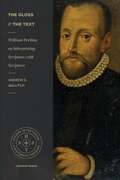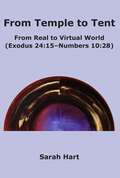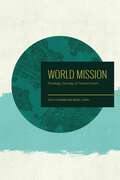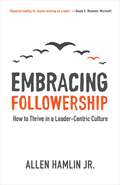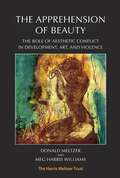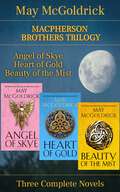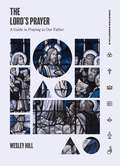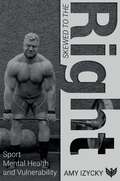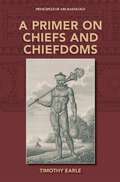- Table View
- List View
Revelation Verse by Verse (Osborne New Testament Commentaries)
by Grant R. OsborneRevelation is like no other book in the New Testament. Its bizarre images need explaining even for seasoned Bible readers, but when we turn to biblical scholars we find that they don't all agree. In Revelation Verse by Verse, Grant R. Osborne offers a clear exposition of the book that takes seriously both its first-century context and what it means today. Where he disagrees with other interpretations of particular images, he briefly mentions them but remains focused on the text throughout. Rather than being a book that stirs up fear, Revelation is instead a hopeful and even devotional book, focused on the certainty of God's bringing his plans to completion, the futility of Satan and his plans, and the glory of the Lamb. Revelation Verse by Verse is the first volume in the Osborne New Testament Commentaries, a new series from noted Bible scholar Grant R. Osborne directed toward pastors and committed laypeople.
The Progressive Mystery: Tracing the Elusive Spirit in Scripture and Tradition
by Myk HabetsA careful exploration of how the identity and mission of the Holy Spirit have been progressively revealed throughout Holy Scripture and then interpreted by the Church. The Progressive Mystery describes how the Spirit has been revealed, understood, and interpreted throughout the sweep of Holy Scripture and the ways in which the orthodox understanding of the mission of the Holy Spirit has developed. An ideal entrée into the study of pneumatology, it introduces readers to the complex history of the theology of the Holy Spirit. Ideal for students, it takes its place among other introductions to pneumatology, as a readable and reliable guide to an elusive topic.
La Salvezza di Zane (Vampiri Scanguards)
by Tina FolsomL'ultima cosa che Zane, vampiro e guardia del corpo, desidera è dover proteggere un'ibrida, metà vampira, metà umana, la cui unica missione, imposta dal padre, è restare vergine. Zane è noto per il suo carattere violento e la totale mancanza di compassione: la rabbia che lo divora, nata dalle atrocità subite durante l'Olocausto, lo ha reso un uomo guidato soltanto dalla sete di vendetta. Ritrovare l'ultimo dei suoi aguzzini è l'unico scopo della sua esistenza. Portia è una giovane ibrida che si trova davanti a un dilemma molto serio: tra poche settimane, il suo corpo si trasformerà definitivamente nella sua forma di vampira. Se vuole evitare di trascorrere l'eternità da vergine, deve trovare un amante prima che il tempo scada, ma proprio per impedirle questo, suo padre assume Zane come guardia del corpo. Dal momento in cui Portia e Zane si incontrano, le regole iniziano a vacillare e un'attrazione proibita esplode con una passione più ardente dell'inferno che Zane si porta dentro. Ma il passato minaccia di dividerli per sempre… a meno che non trovino il coraggio di mettere da parte i pregiudizi, abbandonare l'odio e scegliere l'amore, rinunciare alla vendetta e aprirsi al perdono. INFORMAZIONI SULLA SERIE La serie Vampiri Scanguards è ricca di azione frenetica, scene d'amore bollenti, dialoghi arguti ed eroi ed eroine forti. Il vampiro Samson Woodford vive a San Francisco ed è proprietario di una società di sicurezza e guardie del corpo, la Scanguards, che impiega sia vampiri che umani. E, alla fine, anche delle streghe. Nel corso della serie si aggiungeranno anche guardiani immortali e demoni, per rendere tutto ancora più interessante! Ogni libro può essere letto come un romanzo autoconclusivo si concentra sempre su una nuova coppia che trova l'amore, ma la serie è più piacevole se letta in ordine. E, naturalmente, ci sono sempre alcune battute ricorrenti, lo capirai quando incontrerai Wesley, un aspirante stregone. Desiderio Mortale (Storia breve #½) La Graziosa Mortale di Samson (#1) L'Indomita di Amaury (#2) L'Anima Gemella di Gabriel (#3) Il Rifugio di Yvette (#4) La Salvezza di Zane (#5) L'Amore Infinito di Quinn (#6) La Fame di Oliver (#7) La Scelta di Thomas (#8) Morso Silenzioso (#8 ½) L'Identità di Cain (#9) Il Ritorno di Luther (#10) La Missione di Blake (#11) Riunione Fatidica (#11 ½) Il Desiderio di John (#12) La Tempesta di Ryder (#13) La serie Vampiri Scanguards ha tutto: amore a prima vista, nemici che diventano amanti, incontri fortuiti, colpo di fulmine, eroe alfa, compagni predestinati, guardia del corpo, banda di fratelli, damigella in pericolo, donna in pericolo, la bella e la bestia, identità nascosta, anime gemelle, primo amore, vergini, eroe tormentato, divario di età, una seconda possibilità d'amore, amante in lutto, ritorno dalla morte, bambino segreto, playboy, rapimenti, da amici ad amanti, coming out, ammiratore segreto, ultimo a saperlo, amore non corrisposto, amnesia, regalità, amore proibito, gemelli identici, partner nella lotta al crimine.
The Analyst's Torment: Unbearable Mental States in Countertransference
by Dhwani ShahDhwani Shah moves the focus from using psychoanalytic theory and technique to explore the patient's mind from a safe distance. Instead, he concentrates on the analyst's feelings, subjective experiences, and histories, and how these impact on the intersubjective space between analyst and patient. His eight chapters each highlight a particular emotional state or problematic feeling and explore their impact on the analytic work, which requires emotional honesty and open reflection. This authenticity is vital for every unique encounter within the shared space of both the analyst and patient. The analyst must strive to be responsive, yet disciplined, and this requires the work of mentalization. An ability to "go there" with patients offers the best chance at helping them. The analyst's uncomfortable and disowned emotional states of mind are inevitably entangled with the therapeutic process and this has the potential to derail or facilitate progress. The chapters deal with uncomfortable themes for the analyst to face: arrogance, racism, dread and its close relation erotic dread, dissociation, shame, hopelessness, and jealousy. These bring up common ways in which analysts stop listening and struggle in the face of uncertainty and intensity; the difficulties in facing unbearable experiences with patients, such as suicidality; disruptions to being with patients in an affective and embodied way; and thwarted fantasies of being the "hero". With all of these difficult topics, Shah describes painful and tormenting experiences in a clinically meaningful way that allow growth. In this exceptional debut work, Shah demonstrates that what analysts feel, in their affects, bodies, and reveries with patients, is vital in helping them to understand and metabolise the patients' emotional experiences. This is a must-read for all practising clinicians.
The Ascension of Christ: Recovering a Neglected Doctrine (Snapshots)
by Patrick SchreinerIt's essential to the Gospel, but we rarely talk about it. The good news of Jesus includes his life, death, resurrection, and future return--but what about his ascension? Though often neglected or misunderstood, the ascension is integral to the gospel. In The Ascension of Christ, Patrick Schreiner argues that Jesus' work would be incomplete without his ascent to God's right hand. Not only a key moment in the Gospel story, Jesus' ascension was necessary for his present ministry in and through the church. Schreiner argues that Jesus' residence in heaven marks a turning point in his three-fold offices of prophet, priest, and king. As prophet, Jesus builds the church and its witness. As priest, he intercedes before the Father. As king, he rules over all. A full appreciation of the ascension is essential for understanding the Bible, Christian doctrine, and Christ's ongoing work in the world.
Anglicanism: A Reformed Catholic Tradition
by Gerald BrayWhat is Anglicanism? There are many associations that come to mind. Whether it is the buildings, the unique history, the prayers, or church government, often we emphasize one aspect against others. Is the Anglican church a Protestant church with distinctive characteristics, or a Catholic Church no longer in communion with Rome? In Anglicanism: A Reformed Catholic Tradition, Gerald Bray argues that some theological trajectories are more faithful than others to the nature and history of the Church of England. Readers looking to understand the diversity, nature, and future of Anglicanism will be helped by Bray's historical examination.
Deserting the King: The Book of Judges (Transformative Word)
by David BeldmanThe book of Judges can pose many puzzles for readers today: who were the "judges"? Why was this book written, and how does it fit into the biblical narrative? And how can the story it tells--one of bloodshed, intrigue, and rejection of Yahweh's authority--change our understanding of God today? Deserting the King guides readers through the difficulties that the book of Judges can pose for readers as it traces both the evil and redemption present in Israel's approach to kingship--and, by extension, God. And while examining the book's structure and key themes, author David Beldman draws in stories from his life and the world today, showing how this Old Testament book, in its darkness and heroism, gives us a lens to see God's at work throughout history.
Brand New Mentor's Guide: A 40-Day Guide to Life in Christ
by Shilo TaylorCalling all mentors. We all need others to encourage, challenge, and teach us, but this kind of mentorship is critical in the early stages of a new Christian life. In Brand New: A 40--Day Guide to Life in Christ, Shilo Taylor gives new believers a brief and practical guide through their first steps in their walk with Jesus. The Brand New Mentor's Guide provides a resource for mentors who are walking with these new Christians. With tips for leaders and guided reflections, this mentor's guide is an essential component to a successful mentorship. It will help you facilitate discussion, expand on the daily readings, and wrestle with the questions throughout the 40--day devotional. Taylor brings her years of experience in youth ministry to equip mentors with an essential resource for ministry and outreach.
Jung: An Introduction
by Ann CasementThis book is an introduction to the ideas of the Swiss psychologist and psychoanalyst, C. G. Jung. The first chapter describes his early home life whilst subsequent chapters are devoted to his work in various sectors. This started in psychiatry at Burgholzli Hospital in Zurich, where Eugen Bleuler was the Director, a significant figure in Jung's life for many years. The book goes on to describe at some length the professional relationship between Freud and Jung, and the disastrous impact of their subsequent acrimonious split in 1913 on themselves but, more importantly, on the profession of psychoanalysis itself, both at that time and subsequently. Several chapters elaborate Jung's main concepts, including an extensive investigation of his all-important work on psychological alchemy, which includes 10 black and white illustrations from the alchemical text The Rosarium Philosophorum and 10 black and white ox-herding pictures of Kuo-an from the twelfth-century Buddhist tradition. The rest of the book depicts some of the significant women and men who contributed to analytical psychology, which is the term Jung chose to designate his psychoanalytic discipline. This is used interchangeably with the term psychoanalysis as many Jungians designate themselves psychoanalysts, including the author, as a New York State licensed psychoanalyst. This is also an account of some of the scientific, philosophical, and psychological influences on Jung's thinking. The book concludes with an entry on China, where the author has spent the last few years analysing, lecturing, supervising, and teaching analytical psychology to Chinese psychotherapists, counsellors, and students in Beijing and Shanghai. This comprehensive work is essential reading for all those with an interest in C. G. Jung and his work.
What is the Bible? (Questions for Restless Minds)
by Graham A. ColeThe book that understands you. Christians are people of the book. But does the Bible still speak today? Can an ancient book still be relevant? In What is the Bible?, Graham A. Cole asks why Christians should value God's word. Fundamentally, God's word gives light. It reveals God. It also reveals this world. It gives a new perspective on the past, present, and future. And God's word illuminates you. It knows and understands you better than you do. It doesn't simply answer your questions; it asks questions of you. It will not leave you unchanged. Learn what makes this book so valued by so many people. The Questions for Restless Minds series applies God's word to today's issues. Each short book faces tough questions honestly and clearly, so you can think wisely, act with conviction, and become more like Christ.
The Psychosomatic Therapy Casebook: Stories from the Intersection of Mind and Body
by Jean Benjamin StoraJean Benjamin Stora has worked as a psychoanalyst and psychosomatist for almost five decades. The aim of integrative psychosomatics is to heal the body and mind in relationship to one another rather than treating the body as a machine with parts to be fixed. Thus, Stora explores a patient's current and past life history in relation to physical illness and offers therapeutic support alongside medical treatments. To better understand this revolutionary approach, Stora presents fifteen case studies from the past twenty years. We read of George suffering from hyperlipidemia; Giles, a diabetic facing amputation; Elvira, an alcoholic; Dorothy, who complains the doctors treat body parts but not her; Beatrice facing a reappearance of breast cancer; and ten further patients. This complex process takes into account the fundamental role of the central nervous system in the relationship of mind and body. Thus, neuroscience is a key component of this holistic approach, as well as the new discipline of neuropsychoanalysis. This is most clearly shown in the case of Emma, suffering after brain surgery. The Psychosomatic Therapy Casebook is an excellent introduction to integrative psychosomatics. The stories presented in the first four chapters can be read by anyone with an interest in the subject. The fifth and final chapter is aimed at psychotherapists, psychoanalysts, and doctors looking to gain a greater understanding of the practice. It contains a comprehensive review of the technical points involved and clearly shows the difference between psychoanalytic technique and the technique of psychosomatic therapy. This is an important book in learning to treat the person as a whole rather than split into mind and body.
Preaching Hope in Darkness: Help for Pastors in Addressing Suicide from the Pulpit
by Scott M. Gibson Karen E. MasonHow can a preacher best address suicide from the pulpit? Pastors face many challenges. Suicide in a congregation is amongst the most heart-rending and intimidating. However, the preacher has a unique capacity to engender gospel hope for preparing the congregation and comforting the bereaved. To do so, preachers need help understanding the challenges and opportunities presented by addressing suicide from the pulpit. In Preaching Hope in Darkness, two practitioners in fields that do not typically interact--homiletics (Scott M. Gibson) and psychology (Karen Mason)--work together to support the preacher in this difficult task. Gibson and Mason offer wise advice on a range of topics such as suicide prevention, post-crisis care, and funeral sermon preparation. With an appendix of sample sermons and a sample funeral liturgy, Preaching Hope in Darkness is an essential go-to guide for this difficult topic.
Mastering the Art of Arms Vol 1: The Medieval Dagger
by Guy WindsorIn Mastering the Art of Arms, Volume One: The Medieval Dagger, renowned instructor, author and researcher, Guy Windsor, presents a complete guide to the principles and practice of Italian dagger combat.
The Gloss and the Text: William Perkins on Interpreting Scripture with Scripture (Studies in Historical and Systematic Theology)
by Andrew S. BallitchScripture opens itself up by its own words and interpretation. William Perkins is the father of Puritanism, often remembered for his preaching manual, The Art of Prophecy. Much attention has been given to the Puritan movement, especially in its later forms, but comparatively little has been given to Perkins. In The Gloss and the Text, Andrew Ballitch provides a thorough examination of the hermeneutical principles that governed Perkins's approach to biblical interpretation. Perkins taught that the Bible was God's word as well as the interpretation of God's word. Interpretation is no private matter; it is a public gift of the Spirit of God for the people of God. Ballitch's study sheds light on Perkins as a preacher, theologian, and student of Scripture.
The Power of Music: Psychoanalytic Explorations
by Roger KennedyEmotion is an integral aspect of musical experience; music has the power to take us on an emotional and intellectual journey, transforming the listener along the way. The aim of this book is to examine the nature of this journey, using a variety of perspectives. No one discipline can do justice to music's complexity if one is to have a sense of the whole musical experience, even if one has to break up the whole experience into various elements for the purposes of clarification. The issues raised have some relationship to psychoanalytic understanding and listening, as after all psychoanalysis is a listening discipline; its bedrock is listening to the patient's communications. While of course there are significant differences between understanding of, and listening to, a musical performance and a patient in a consulting room, the book explores common ground. Evidence from neuroscience indicates that music acts on a number of different brain sites, and that the brain is likely to be hard-wired for musical perception and appreciation, and this offers some kind of neurological substrate for musical experiences, or a parallel mode of explanation for music's multiple effects on individuals and groups. After various excursions into early mother/baby experiences, evolutionary speculations, and neuroscientific findings, the book's main emphasis is that it is the intensity of the artistic vision which is responsible for music's power. That intense vision invites the viewer or the listener into the orbit of the work, engaging us to respond to the particular vision in an essentially intersubjective relationship between the work and the observer or listener. This is the area of what we might call the human soul. Music can be described as having soul when it hits the emotional core of the listener. And, of course, there is 'soul music', whose basic rhythms reach deep into the body to create a powerful feeling of aliveness. One can truly say that music of all the arts is most able to give shape to the elusive human subject or soul.
From Temple to Tent: From Real to Virtual World (Exodus 24:15 - Numbers 10:28)
by Sarah L. HartThe principal interest of the text on the tabernacle tent, Exodus 24:15 - Numbers 10:28, is Israelite worship-cultic place, the cultic people, and laws for the regulation of cultic life. The method followed is description of the biblical text and collation of the evidence as would a classicist go about classifying an ancient Greek Vase. The findings reveal a virtual world of Israelite cult. The transportable tabernacle tent with its courtyard and altar resembles a temple in its complexity. Through words the reader is invited into the atmosphere of the tabernacle tent where all the senses are evoked. The beautifully embellished fore-room of the tent illuminated by the light of the lamp-stand is seen, the waft of incense smelt, the atmosphere of fear or attraction that emanates from the epicentre of holiness felt. The tabernacle tent is constructed of words, not of stones. It is indestructible and does not succumb to the vagaries of time, as pristine today as it was over 2,500 years ago when it was first created.
Reflecting on Therapy
by Michael JacobsMichael Jacobs is the author of key texts, such as Psychodynamic Counselling in Action and The Presenting Past. Looking back over fifty years' experience as a therapist and reflecting on some forty years as a supervisor and teacher, he invites you to join him and reflect upon issues uncovered in the therapy room. Therapists are encouraged to engage in reflective practice, thinking through what they are saying and doing, together with presenting their work in supervision in order to engage in fine-tuning their insight and skills. However, it is hard to find the time with so many demands pressing in. Michael presents various situations, phrases and practices which may evade reflection since they are so common in the consulting room, or which may challenge assumptions that easily become habitual in a therapist's practice. He unpacks apparent conventional phrases, such as 'How are you?', 'Did you see ...?', 'And ...'. He says the unsayable, looks at the place of CPD, questions 'expertise', the impact of failure, Freud's cigars, expectations on the therapist, being a therapist, the value of apologies, letting be, niggles, the vicissitudes of memory, the pointlessness of questions, what therapists miss, hopes, goals, taboos, finishing therapy, money, notes ... and many, many more significant possibilities that arise in the course of a week's regular sessions. This beautiful little book contains space within for your own notes, thoughts, and reflections after each reflection from Michael. This gives you the opportunity to ponder, to savour, to develop or disagree on the ideas you encounter. Take your time, slow down, and allow your thoughts to grow.
World Mission: Theology, Strategy, and Current Issues
by Scott N. Callaham Will BrooksWorld missions needs a fully biblical ethos. This is the contention of the editors of and contributors to World Mission, a series of essays aimed at reforming popular approaches to missions. In the first set of essays, contributors develop a biblical theology of world missions from both the Old and New Testaments, arguing that the theology of each must stand in the foreground of missions, not recede into the background. In the second, they unfold the Great Commission in sequence, detailing how it determines the biblical strategy of all mission enterprises. Finally, they treat current issues in world missions from the perspective of the sufficiency of Scripture. Altogether, this book aims to reform missions to be thoroughlyâ€"not just foundationallyâ€"biblical, a needed correction even among the sincerest missionaries.
Divine Audacity: Unity and Identity in Hugh of Balma, Eckhart, Ruusbroec, and Marguerite Porete
by Peter S. DillardIn Divine Audacity, Peter Dillard presents a historically informed and rigorous analysis of the themes of mystical union, volition and virtue that occupied several of the foremost theological minds in the late thirteenth and early fourteenth centuries. In particular, the work of Marguerite Porete raises complex questions in these areas, which are further explored by a trio of her near contemporaries. Their respective meditations are thoroughly analysed and then skilfully brought into dialogue. What emerges from Dillard's synthesis of these voices is a contemporary mystical theology that is rooted in Hugh of Balma's affective approach, sharpened through critical engagement with Meister Eckhart's intellectualism, and strengthened by crucial insights gleaned from the writings of John Ruusbroec. The fresh examination of these thinkers - one of whom paid with her life for her radicalism - will appeal to philosophers and theologians alike, while Dillard's own propositions demand attention from all who concern themselves with the nature of the union between the soul and God.
Embracing Followership: How to Thrive in a Leader-Centric Culture
by Allen HamlinWe live in a leader-centric culture. We're constantly bombarded with advice on how to achieve leadership positions or how to lead well once we get there. We've made leadership out to be the mark of success. But what if leadership isn't our goal? What if we want to do well where we are? Can we use our skills to perform with excellence--as followers? In Embracing Followership, Allen Hamlin Jr. shares from his own experience how you can succeed as a follower without anyone reporting to you. You offer unique contributions to every group you're a part of, and you don't need to be a leader to make a difference.
The Apprehension of Beauty: The Role of Aesthetic Conflict in Development, Art and Violence
by Meg Harris Williams Donald MeltzerThis volume has grown over the years as a family project of Martha Harris, her two daughters Meg and Morag and her husband, Donald Meltzer. It therefore has its roots in English literature and its branches waving wildly about in psychoanalysis. It is earnestly hoped that it will reveal more problems than it will solve.
Macpherson Brothers Trilogy (Macpherson Series)
by Jan Coffey May McGoldrickUSA Today Bestselling Author Passion…Betrayal…Stolen Love! From the wild shores of the Scotland's Western Isles to the bloody fields of France to the glittering courts of Europe, the Macpherson Trilogy follows a family's fight for Scottish independence against the Tudor king, Henry VIII. The Complete Trilogy in One Volume Angel of Skye Heart of Gold Beauty of the Mist
The Lord's Prayer: A Guide to Praying to Our Father (Christian Essentials)
by Wesley HillYou pray it. But do you understand it? The Lord's Prayer has become so familiar to us that we don't think about what we're praying. It's a portrait of Jesus' heart. And in it Christians from different times, places, and traditions have been united. We pray it, but do we actually believe it? When Jesus taught his followers how to pray, he emphasized how uncomplicated it should be. There's no need for pretense or theatrics. Instead, simply ask for what you need as though you were speaking with your earthly father. This opens a window into Jesus' prayer life and presents us with a portrait of his heart for his followers. Wesley Hill re-introduces the Lord's Prayer. He shows us a God who is delighted to hear prayer. Petition by petition, in conversation with the Christian tradition, he draws out the significance of Jesus' words for prayer today.
Skewed to the Right: Sport, Mental Health and Vulnerability
by Amy IzyckyThe demands of the high-performance athlete are huge, with many celebrated for their achievements, and put on a pedestal for admired personality traits such as discipline, sacrifice, commitment, and focus. This book seeks to explore the celebrated traits of the high-performance athlete and, by doing so, to increase awareness of the vulnerability that such traits also present. Through discussion with professional sports people and presentation of their own personal stories the book explores obsessionality, masochism, and focus, and how these characteristics can enhance performance on the field yet hinder life off it and may even develop into clinically diagnosable mental health difficulties. In psychology, assessments are based on statistical phenomena; the title Skewed to the Right is based on the 'bell curve' that is shown through a graph whereby the majority sit in the middle with a few clusters at either on of the extremes. The suggestion is that elite athletes are 'skewed to the right' on a number of key traits that put them between the 'general' population and those with a clinical diagnosis. The book opens with an exploration of weight-restricted sport and how making weight is achieved through practices that become culturally acceptable in the sporting world yet would be seen to be classified as clinically diagnosable eating disorders in the medical world. It then moves on to personality traits that help and hinder - those skewed to the right: masochism, obsessionality, and focus. Part 3 looks at one trait skewed to the left - acceptance - that many sportspeople struggle with. The book closes with a section exploring points of vulnerability for all athletes and ends with a look at where we can go from here. The aim of the book is to increase social awareness of the reality of life for the successful high-performance athlete and the challenging dynamics that exist in sporting culture today. It will be of interest to psychologists, psychotherapists, trainees, and anyone with an interest in sporting culture.
A Primer on Chiefs and Chiefdoms (Principles of Archaeology)
by Timothy EarleChiefs are political operatives who hold titles of leadership over groups larger than intimate kin-based communities. Although they rule with the consent of their group, they are all about building personal power and respect. Many scholars have viewed chiefs as problem solvers--defending groups against aggressors, resolving disputes, providing support under hardship, organizing labor for community projects, and redistributing goods among those in need. Chiefs do these things, but much of what chiefs do is accumulate benefits for themselves, staying in power and legitimizing control. Anthropological archaeology is well suited to pursue the study of chiefs, their leadership institutions (chiefdoms), and long-term historical processes. The author argues that studying chiefdoms is essential to understanding the role of elemental powers in social evolution. As an illustration, he studies chiefs and their power strategies in historically independent prehistoric and traditional societies and discusses how they continue to exist as powerful actors within modern states.

